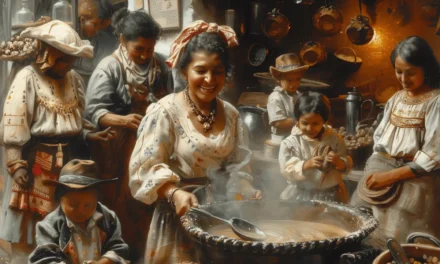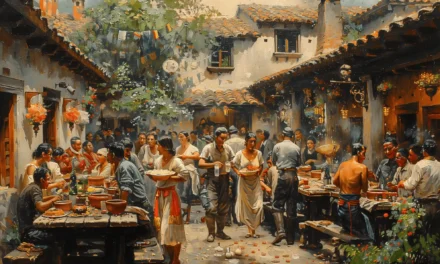Bread is an old friend of ours – it has been by our side through thick and thin since prehistorical times! Not only is bread a reliable source of food stability, but also a symbol of abundance. We’ve come a long way since bread was first introduced, with various shapes, recipes, and techniques now available. High five to our ancient ancestors – without their determination to mill, mix, and leaven, we wouldn’t have gained the nutrition benefits that bread offers today! It’s safe to say that bread isn’t just a nice addition to our lives. It’s essential for our survival.
Ancient Artisans, Modern Magic: 30,000-Year-Old Flatbread Found
Thanks to some savvy scientists scouring Italy, Russia, and the Czech Republic, we now know that 30,000 years ago, prehistoric people had a knack for baking up some tasty flatbread. This tasty treat isn’t just ancient history, though. It’s a delicious blast from the past. Researchers no longer have to remain in the dark about the paleolithic peoples’ diets. With this newfound insight, we now know they had a healthy blend of meat and carbohydrates. Talk about prehistoric balance1.
It’s almost as if the people living in the Black Desert 14,000 years ago knew what the modern world would come to understand—baking the perfect loaf of bread just takes a little bit of magic! And based on the evidence, it seems like they were determined to find the recipe. With no agricultural practices at their disposal, these hunter-gatherers helped set a standard for baking the perfect loaf of bread, using gazelle, hares, and birds to capture the flavor and texture. During feasts and celebrations, these people would come together to practice their artisanal technique, milling the collected cereal with a finesse only a master artisan could achieve2.
A Primitive Revolution: From Crushing Hand to Delightful Dishes
At first, grain was crushed by hand with pestle and mortar – it was kind of like getting an arm workout at the gym! In Egypt, at 8000 B.C., they developed a much more efficient way of crushing grain – the quern. It was like inventing a whole new machine for the job! The first bread made from various grains was much more like ancient flatbreads that you might find today, like Indian chapattis and Mexican tortillas. Think of it as taking a step back in time to get your bread fixed3.
Some studies have unearthed an ancient recipe book made up of all the wondrous cereals of yesteryear. They discovered the evidence of barley, wheat, spelt, rye, oat, and millet among the lake dwellings of Switzerland – all of which were regularly used by the first settlers to make all sorts of delicious dishes such as flatbread, porridge and primitive versions of cakes. So while we may never know what they tasted, it’s safe to say it was a real treat to experience the variety of flavors and textures these ancient grains provided4.
This miraculous grain was spread to the Balkans and all over Europe like wildfire and eventually even reached the distant shores of Britain. All this happened in the blink of an eye (well, in the time span of 3700 B.C.), turning grain into a staple food everyone enjoyed. Like a fairy tale’s happy ending, Egypt gave all of Europe a big, nutritious hug4.
Baked to Perfection: Secrets of Ancient Egyptian Bakeries
Baking bread is a skill that can be linked all the way back to ancient Egypt, where the warm climate was the perfect place to create bread masterpieces. Wild yeasts swarmed the multi-grain flour mixtures, allowing bakers to experiment with every kind of leavened dough they could think of. And, let’s not forget, Egypt is also the birthplace of the closed oven – perhaps the best tool a bread-making enthusiast could ever wish for3.
In Egypt, bread had such importance that it was roughly equal to money. Talk about a dough nation! People even got paid for their hard work – such as building the pyramids – in bread. Amazingly, such a simple food source had significance in Ancient Egypt3.
Flat Bread Voyage: A Culinary Journey
The world is like a giant pantry full of bread! Everywhere you go, there’s a different bread with unique origins, techniques, and recipes tied to the particular region’s agricultural practices. For example, in the Fertile Crescent, you’ve got delicious pita bread that’s perfect for dipping in fares such as hummus or tzatziki; in the sub-Sahara, there’s finger-licking injera bread to scoop up curries; Ethiopia boasts fragrant teff bread; China has fluffy mantou buns; New Guinea has sago bread; Mesoamerica features basically a corn-based bread; Amazonia has casabe; Andes have their famous spongy Chuta bread; and back in the good ol’ USA, we have the great classic: cornbread5.
It’s like flatbreads took a leisurely stroll around the world! Like the first wheat and barley crops, flatbreads moved slowly and steadily from the Fertile Crescent, traveling north towards the Mediterranean and then south around the Arabian Peninsula, the Indian Subcontinent, and the Anatolian Peninsula. Finally, after a brief trip to the Balkans and Caucasus5.
Unleavened bread was a staple ingredient in the Neolithic diet, as it has been for centuries. It’s like a trusted old friend – always there to carry you forward when you need it! Think of it as the ancestors of all the delicious bread we know and love today, from lavash from the Middle East to pita from Greece, rod and chapati from India, tortilla from Mexico, and johnny cake from North America. Bakers throughout the centuries have taken advantage of the simple leavening process, where the dough is left in the perfect environment for bacteria and yeast to work their alchemical magic – be sure to thank them for your favorite bread next time you’re at the bakery6.
The Ballet of Bread: A Broad Historical Perspective
Making bread has been around since time immemorial. The word “dough” is derived from an Indo-European expression referring to activities involving kneading and shaping hands into a desired result – like a sculptor turning clay into an exquisite piece of art. Fast forward to the Middle Ages when the good-old English language began incorporating French terms. The universal term for bread then was “half,” which eventually turned into “loaf” today. Apparently, English changed to a German noun for its sustenance source- something like “morsel” or “piece.” Historians believe that the term for bread might have been derived from a more ancient root-matching brewing, but more plausible is the notion that the word “bread” is derived from a root indicating the process of breaking something into minimal parts. Kneading bread is almost like the choreography of a ballet – the stirring, the kneading, the rising of the dough, the baking. All art forms require a flavorful amount of creativity, and bread-making certainly is no exception7.
- AFP. (2019, October 19). Prehistoric man ate flatbread 30,000 years ago: study. Retrieved from Phys.org: https://phys.org/news/2010-10-prehistoric-ate-flatbread-years.html[↩]
- Briggs, H. (2018, July 17). Prehistoric bake-off: Scientists discover oldest evidence of bread. Retrieved from BBC News: https://www.bbc.com/news/science-environment-44846874[↩]
- Federation of Bakers Ltd. (n.d.). History of bread – Antiquity. Retrieved from About the bread industry: https://www.fob.uk.com/about-the-bread-industry/history-of-bread-antiquity/[↩][↩][↩]
- Ashton, J. (1904; 2016, October 5). The History of Bread From Pre-historic to Modern Times. Retrieved from Project Gutenberg: http://www.gutenberg.org/files/53219/53219-h/53219-h.htm[↩][↩]
- Pasqualone, A. (2018, February 17). Traditional flat breads spread from the Fertile Crescent: Production process and history of baking systems. Retrieved from Science Direct: https://reader.elsevier.com/reader/sd/pii/S235261811830009X?token=C01C7479C25998B9B0157CE22FD959AEF60287D80138CB73CDDB6913AF0EB387E2D0CF8C499C4F6FA598FE9F39FFD1FE[↩][↩]
- McGee, H. (2011). La Cocina y Los Alimentos (Sexta ed.). (J. M. Ibeas, Trans.) Barcelona, España: Debate.[↩]
- Dean, S. (2013, August 2). The Etymology of the Word ‘Bread’. Retrieved from Bon Appétit Magazine: https://www.bonappetit.com/test-kitchen/ingredients/article/the-etymology-of-the-word-bread[↩]




